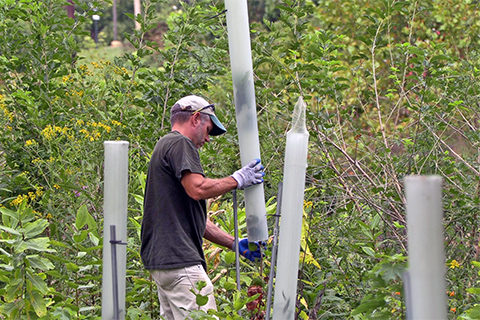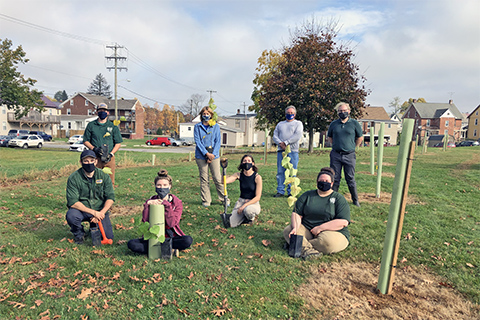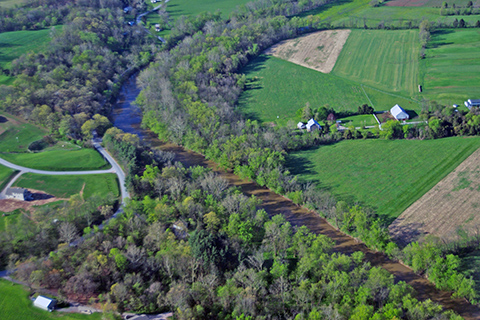Over the past few years, DCNR has put a renewed focus on streamside forests, or the implementation of riparian forest buffers as a best management practice for water quality.
But what is a riparian forest buffer, and why are we suddenly so focused on replanting our streamside lands?
The term “riparian” comes from the Latin words “ripa” and “riparius,” meaning “bank,” as in riverbanks.
According to Merriam-Webster, the current definition for riparian is “relating to or living or located on the bank of a natural watercourse (such as a river) or sometimes of a lake or a tidewater” -- so a riparian forest is simply a forest along river or other waterbody.
Streamside Buffers are a Best Management Practice for Clean Water

Riparian forest buffers have come into focus in Pennsylvania as the commonwealth strives to meet the federal mandates set by the Environmental Protection Agency for reducing nutrient and sediment pollution in the Chesapeake Bay.
More than half of the land area in Pennsylvania is a part of the Chesapeake Bay watershed, and our state is the largest source of pollution flowing into the Chesapeake Bay and damaging its health.
Streamside forest plantings are one of the most cost-effective ways to improve water quality, and Pennsylvania has a lot of work to do on water quality improvement if we’re going to come anywhere close to meeting the goals for the Chesapeake Bay.
But riparian forest buffers aren’t only good for the Bay, they’re essential to future of Pennsylvania, our citizens, and our natural resources.
Pennsylvania has a goal of planting 95,000 acres of streamside buffers statewide by 2025.
DCNR Streamside Forest Buffer Team

For the past five years, DCNR has been leading the effort to plant trees in the riparian areas along streams, with the help of other state agencies and many, many external partners.
DCNR currently has a four-person team in the Bureau of Forestry focused on providing technical assistance, engaging partners, and planting trees along streams.
In addition to Watershed Forestry Program Manager Teddi Stark, the team includes:
- Regional Riparian Buffer Specialist Zach Carnegie
- Riparian Buffer Community Engagement Specialist and Acting Lawn Conversion Program Coordinator Kelsey Miller
- Regional Riparian Buffer Specialist Marlin Graham
The team works with Bureau of Forestry Service Foresters around the state on outreach and technical assistance; with DCNR’s Bureau of Recreation and Conservation on grants for streamside buffers and support to grantees; and with the Bureau of State Parks on partner projects and planting locations.
All of the buffer team members can be reached through DCNR’s online contact form or by calling 717-705-2820.
2020 Streamside Forest Buffer Accomplishments

This year has required perseverance and resilience; however, there are several notable accomplishments related to streamside forest buffers including:
Public Outreach
The Buffer My Stream outreach effort was launched in the summer, involving direct mail to residential and rural landowners in Adams, Franklin, Huntingdon, Lancaster, and York counties to encourage them to register for free technical assistance and funding to help them plant native trees and shrubs on their properties.
More than 180 property owners responded and were all contacted by DCNR staff and partners.
Four plantings on properties occurred this fall, with more scheduled for next spring.
Forest Buffer Summit
Originally scheduled in March, the annual Forest Buffer Summit had to pivot quickly when mitigation efforts prevented it from occurring in person.
The result was the 2020 Buffer Summit Webinar Series, which has reached more than 6,000 people. All of the webinars can be found online in the Pennsylvania Clean Water Academy.
Buffer Tracking Tool
A new reporting and tracking tool called PracticeKeeper is now in place for buffers, allowing DCNR staff and external partners to input acres if streamside buffers they plant, including drawing in the buffers on a map and recording a number of different details about them.
Done in coordination with the Department of Environmental Protection, the tool will allow Pennsylvania to report its successes to the federal government and the public.
Advisory Committee
One quarterly meeting of the Buffer Advisory Committee (more than 60 stakeholders and partners) was dedicated to discussing Diversity, Equity, Inclusion and Justice related to streamside buffers.
Among the topics were workforce development and mentorship, and equitable funding and grants.
A next step in the coming year is to understand how to better serve Environmental Justice communities.
Funding for Buffers
In addition to allocating more than $2 million in federal funding for buffers, DCNR also provided Community Conservation Partnerships Program funding totaling $673,700 to support the planting of about 93 acres of trees along streams.
Save the Date for the 2021 Riparian Forest Buffer Summit

In 2021, DCNR’s buffer work will continue to grow roots, and strategically branch out, cultivating the shift that takes the commonwealth away from naked streamsides, and toward forested watercourses and cleaner water.
Partners and interested landowners should save the date for the virtual 2021 Riparian Forest Buffer Summit that will occur March 10 and 11.
Check the DCNR website or follow the department on social media to be notified when more details are available.